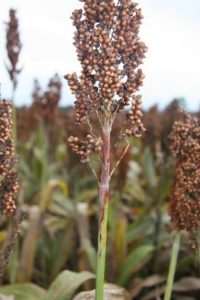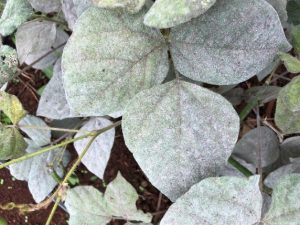
Head blight in sorghum caused by Fusarium sp. (Photo by L. Kelly / M. Ryley)
Recent rainfall has led to opportunistic late plantings in some areas. The current high relative humidity may also lead to an increased risk of disease in some crops.
Department of Agriculture and Fisheries (DAF) plant pathologists are encouraging Northern Region grain growers to submit disease samples (particularly powdery mildew in mungbeans) for diagnosis as part of effective paddock monitoring and management.
Accurate in-crop disease diagnosis is essential for developing and implementing disease management techniques. Below are some of the diseases to keep a particularly close eye out for this season.
Damping off
Recent rainfall events across the northern region have resulted in a number of crops suffering pre- and post-emergence ‘damping off’ of seedlings. Damping off can be caused by a variety of fungal species (such as Pythium, Fusarium, and Rhizoctonia) that may be present in the seed, or endemic to many soils across the region.
- Under wet conditions these fungal pathogens can cause pre-emergence damping off by causing seeds to rot.
- Post-emergence damping off occurs when the fungi infect the roots or stem of seedlings, resulting in plant death. Surviving plants may be stunted and result in crops with poor stands.
The disease is often more severe in poor-draining soils and in crops where seed was sown deeply.
Halo blight, fusarium wilt and powdery mildew

Powdery mildew in mungbean cv. Jade-AU caused by the recently discovered Erysiphe sp. (Photo by L. Kelly)
Mungbean growers should keep a close eye on crops for the development of diseases that favour wet conditions, such as halo blight and fusarium wilt.
Powdery mildew is also expected to impact mungbean crops across the region as temperatures become cooler. Recent findings indicate that two pathogens can cause powdery mildew in mungbean. Little is known about either pathogen, so growers are encouraged to send in any samples of powdery mildew this season so that researchers can determine which species is impacting crops in your region.
Ergot, head blight and grain moulds
Late plantings of sorghum are at risk of developing diseases such as ergot, head blight and grain moulds. These diseases can result in significant damage to grain quality and yield.
Where to send samples?
Growers and advisers in northern New South Wales, and southern and central Queensland should inspect crops closely for disease and send samples (via courier or express post) to:
Lisa Kelly
Department of Agriculture and Fisheries
203 Tor St
Toowoomba
Queensland, 4350.
Please email [email protected] prior to sending samples.
Fresh samples of diseased plants should be double bagged in paper bags. If using plastic bags, ensure excess moisture is limited to minimise decay in transit. Clearly label the samples with the following information:
- grower’s contact details and crop location
- variety and age of the crop
- incidence and distribution of symptoms
- paddock history
This research is supported through the Grains Research and Development Corporation (GRDC) through the project Surveys and associated diagnostics of the incidence and severity of diseases of cereal and pulses within the Northern Region (DAQ1907-001RTX).
